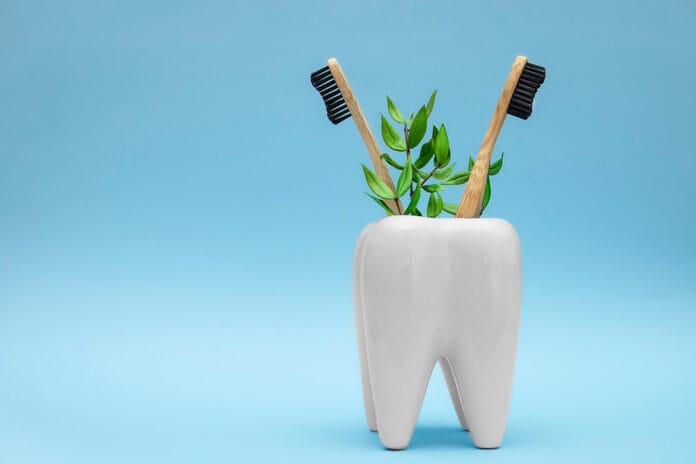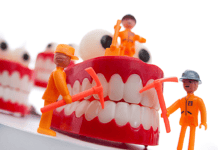Dental offices create massive amounts of waste. I often feel guilty when I throw away the plastic barriers from my room – not to mention the hundreds of gloves, sterilization pouches, prophy angles, and so on. The waste is multiplied by every single dental appointment.
Is there a way to cut down on waste while still upholding the highest standards of patient care? We obviously need to prevent cross-contamination and keep our patients safe. Remember the Hippocratic Oath, “First, do no harm.” We cannot throw these barriers to the wayside – to do so would be negligent. Safety standards and protocols are in place for patient protection, and I would never encourage anyone to stray away from those.
Furthermore, per the Centers for Disease Control and Prevention, we cannot reuse any single-use items.1 Single-use items are to be used on one patient and then discarded because items designed as “single-use” cannot be run through a steam sterilizer and reliably disinfected.1 I’m even hesitant to recommend reusable air/water tips since research has shown those items can harbor pathogens even after going through the sterilizer.2
Let’s take a look at what can be done with some practical tips to make a dental office more sustainable.
1) Digital, digital, digital
Can you imagine how much more waste would be created if we all still used film radiographs? All the plastic packets, lead-lined foil, and chemicals to process the film would be overwhelming. Luckily, most offices have switched to digital radiographs. But radiographs are just the tip of the iceberg.
The more we digitalize a practice, the less waste we will produce. Some examples include digitizing patient paperwork and appointment reminders, routing slips, and payroll. Incorporating digital scanners and doing away with print magazines in the waiting room can help decrease waste, too.
Patient Paperwork
Email a link to new patient paperwork that saves the information into the office’s software and doesn’t need to be printed at home. Consent forms and treatment plans can be emailed out the same way. Encourage patients to fill the forms out online ahead of time. If they must fill out the paperwork in the office, a tablet can be used instead of printing it. If a tablet is used, make sure to disinfect it properly between uses.
Treatment plans can also be presented to patients on tablets and sent via email or text, along with a receipt. Software like CareStack and RevenueWell can assist with integrating this digital information into the office’s computer system.
Many specialists have digital referral options on their websites. Even if they don’t, a referral template with the specialist’s contact information could be made into a Word document, customized with the patient’s information, and emailed to the patient.
Routing Slips
If an office is using paper routing slips for patients, brainstorm ways to reduce that paper. Some offices have hygienists and assistants “walk out” the treatment they completed on the computer instead of at the front desk. Information from the routing slips can also be communicated via instant message to the front desk. A note on the patient’s appointment block on the digital schedule can be used instead of paper as well.
If paper routing slips can’t be avoided, try making the paper smaller. Perhaps instead of using a full sheet of paper, make four routing slips on one piece of paper and cut the paper into fourths.
Payroll
Use direct deposit for payroll with PDF paystubs.
Waiting Room Magazines
Get rid of any magazines in the waiting room. Most people just play on their phones anyway. A sign or a gentle reminder might be needed to get them away from their phones when it’s time to go back for treatment.
Digital Scanners
Digital dental scanners can eliminate the need for alginate impressions and the need for a lab’s driver to pick up those impressions.
Patient Appointment Reminders
A lot of offices send postcards reminding patients of upcoming appointments and scheduling recall appointments. This can be replaced with an email or text message.
2) Watch expiration dates
Rotate stock regularly and be mindful of when products are due to expire. Last year, I noticed I had several caramel-flavored fluoride varnishes that were going to expire in three months. I started encouraging my patients to try the caramel flavor, and I was able to use them before they expired.
Remember FIFO: First in, first out. This means that supplies should be used in the order they were purchased. New items should be stocked behind the existing supplies so that nothing has a chance to expire. Be aware of how much of each supply you order so that you don’t end up ordering more than you can use before the expiration date.
If a product does expire, see if it can be used by a dental student on a typodont. While expired products should never be used on humans, dental students often work on typodonts or extracted teeth, and I’m sure they would make good use of any expired composite, bond, or other expired items.
3) Recycle what you can
Paper cups can be recycled if they have dried out and are clean. Wet items in a recycling bin may lead to mold and contaminate other recyclables.
Broken stainless steel instruments can be sent for recycling at companies such as ProDentUSA..
Companies such as BillsforDrills will buy handpieces, attachments, ultrasonic scalers, and many other items, often even if they are broken.
Companies such as TechWaste Recycling will pick up old radiograph units and films. They will also accept old computers and include data destruction.
TerraCycle and Colgate created the Colgate Oral Care Free Recycling Program. In this program, toothbrushes, empty toothpaste tubes, and empty floss containers can be mailed in for recycling. Dental offices can also register as public drop-off spots for these items.
4) Know what shouldn’t be recycled
Putting items in the recycling bin might make us feel better, but putting the wrong things in recycle bins can cause many problems. Plastic bags and shredded paper can jam the gears of recycling machinery, and non-recyclable items can contaminate batches of good recyclables.3
Check your local recycling guidelines if you’re unsure if something is recyclable.
5) Dispense patient home care supplies by request
I’m admittedly a little stingy with handing out home care supplies. I ask my patients if they want a toothbrush and/or floss. Many patients don’t want anything, and many who own an electric toothbrush don’t want a manual toothbrush. I also ask if they want a bag or not.
I ask my patients because I’ve given my husband home supplies, and he never uses them. They sit in a drawer in my bathroom. I don’t want to build a graveyard of samples in other people’s bathrooms, too. I’ve found that if I hand people a bag of home care supplies, they will most likely take it. But if I ask them what they’d like, they tend to take less.
Sure, there are times when I want to give a patient a rubber tip stimulator or an end tuft brush, but my default of samples is minimal. My office stopped supplying single-use pre-pasted toothbrushes in our bathroom, and we have not even been supplying mini tubes of toothpaste. Our patients don’t seem to mind.
6) Patient education
Tell all patients over age three that they only need to use a pea-sized amount of toothpaste and not a long strip, as the commercials show. Let them know that floss picks made from biodegradable materials are available. Encourage patients to try floss that comes in glass or cardboard containers. Recommend toothbrushes made of bamboo or recycled plastic.
We see so many patients, so our words can really have an impact. Some patients may be skeptical about taking sustainability advice while in a plastic-filled operatory, but let them know we are bound by safety and infection control regulations first and foremost.
In Closing
It’s always a good idea to evaluate the workings of our offices and see if there is room for improvement. Think about what goes into the garbage and recycle bins at work and brainstorm possible changes. While some waste is inevitable, small changes can add up to make a big difference.
Before you leave, check out the Today’s RDH self-study CE courses. All courses are peer-reviewed and non-sponsored to focus solely on pure education. Click here now.
Listen to the Today’s RDH Dental Hygiene Podcast Below:
References
- Kohn, W.G., Collins, A.S., Cleveland, J.L., et al. Guidelines for Infection Control in Dental Health-Care Settings – 2003 [MMWR Report No. 17]. Centers for Disease Control and Prevention. 2003; 52: No. RR-17. http://www.cdc.gov/mmwr/PDF/rr/rr5217.pdf
- Inger, M., Bennani, V., Farella, M., et al. Efficacy of Air/Water Syringe Tip Sterilization. Australian Dental Journal. 2014; 59(1): 87-92. https://doi.org/10.1111/adj.12146
- Mullen, L. (2023, December 15). Recycling’s Most Common Contaminants. University of Colorado Boulder. https://www.colorado.edu/ecenter/2021/04/15/recyclings-most-common-contaminants












